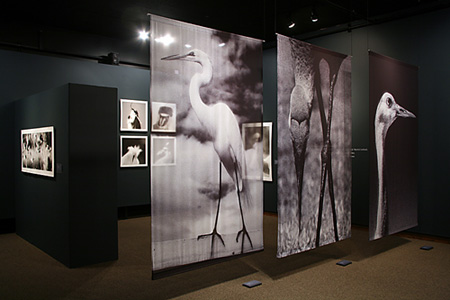
For over a decade, photographer Rosalie Winard has traveled the country by foot, canoe, airboat, and ATV, taking pictures of large birds of the wetlands from Florida to California, Louisiana to North Dakota. Her remarkable portraits are the subject of a national traveling exhibition and book, Wild Birds of the American Wetlands (Welcome Books, $39.95; ISBN 978-1-59962-034-3). Her lyrical images are punctuated with an ethereal palette of white, gray, and black and are alight with Winard's passion for the avian world and its endangered terrain. Alternately meditative and exhilarating, abstract and literal, they capture the birds' remarkable habits and prehistoric forms, as well as their ineffable elegance and humor.

horizontal gatefold from Wild Birds of the American Wetlands
Wild Birds of the American Wetlands
By Rosalie Winard
Foreword by Temple Grandin
Essay by Terry Tempest Williams
Published by Welcome Books
128 pages, 13 1/2" x 8 7/8"
100 black-and-white tritone photos
1 horizontal & 3 vertical gatefolds
clothbound with dust jacket
Hardcover, $39.95 ($45.00 CAN)
ISBN 978-1-59962-034-3
Wild Birds of the American Wetlands is a monumental and breathtaking study of some of the country's most beautiful birds—Great Blue Heron, White Ibis, Snowy Egret, Sandhill Crane, Roseate Spoonbill, American White Pelican Wood Stork, and many more—and of their vanishing habitats. Twenty-eight species are featured in the book. From coastal wetlands in California to the Platte River in Nebraska and the Great Salt Lake in Utah, Winard uses her thirty years of experience observing these winged creatures along with her mastery of photography to illuminate the importance of avian and wetland conservation.
By Rosalie Winard
Foreword by Temple Grandin
Essay by Terry Tempest Williams
Published by Welcome Books
128 pages, 13 1/2" x 8 7/8"
100 black-and-white tritone photos
1 horizontal & 3 vertical gatefolds
clothbound with dust jacket
Hardcover, $39.95 ($45.00 CAN)
ISBN 978-1-59962-034-3
Winard's camera lens has replaced her binoculars as she searches for images that depict the birds' elusive aspects and paradoxes: their simultaneous fragility and power, tranquility and action, stillness and momentum. At once a documentary photographer, artist, and student of natural history, Winard, in each of her photographs, slips soundlessly into a vivid and detailed realism.
The book is lavishly illustrated with 100 black and white tritone photos, and includes one horizontal and two vertical gatefolds.

